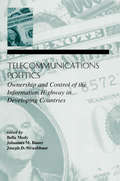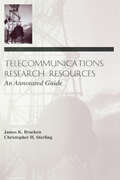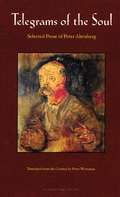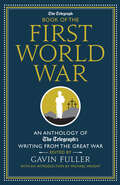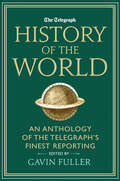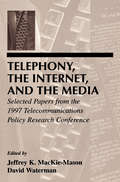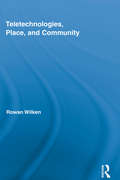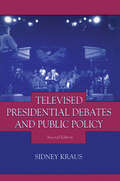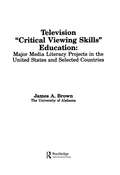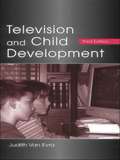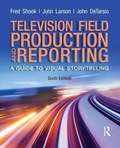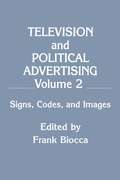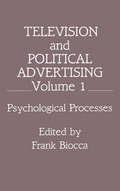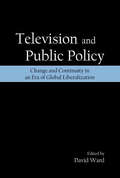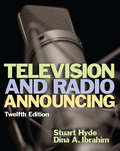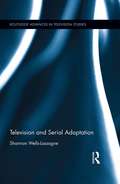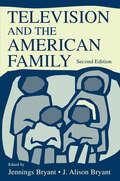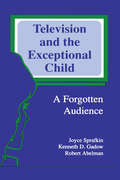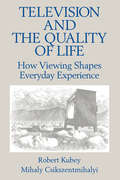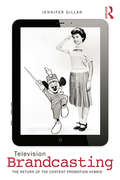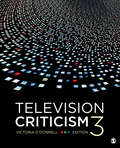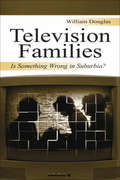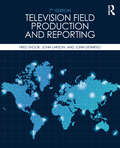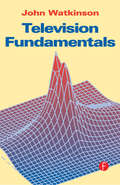- Table View
- List View
Telecommunications Politics: Ownership and Control of the information Highway in Developing Countries (Lea Telecommunications Ser.)
by Bella Mody Johannes M. Bauer Joseph D. StraubhaarThis volume brings together scholars and policymakers to address the issue of telecommunications policy in developing countries. It elaborates on the position that economics and technology determine the framework for discussion, but politics makes the decision. Politics, in this case, refers to the dynamics of the power structure generated by the h
Telecommunications Research Resources: An Annotated Guide
by James K. Bracken Christopher H. SterlingAs the telecommunication and information field expands and becomes more varied, so do publications about these technologies and industries. This book is a first attempt to provide a general guide to that wealth of English-language publications -- both books and periodicals -- on all aspects of telecommunication. It is a comprehensive, evaluative sourcebook for telecommunications research in the United States that brings together a topically-arranged, cross-referenced, and indexed volume in one place. The information provided is only available by consulting a succession of different directories, guides, bibliographies, yearbooks, and other resources. On the one hand, it is a directory that describes in detail the major entities that comprise the American telecommunication research infrastructure including federal and state government offices and agencies, and private, public, and corporate research institutions. On the other hand, it is a bibliography that identifies and assesses the most important and useful reference and critical resources about U.S. telecommunication history, technology, industry and economics, social applications and impacts, plus policy, law and regulations, and role in the global telecommunication marketplace. No existing guide covers all of these aspects in the depth and detail of this volume.
Telegrams of the Soul
by Peter Wortsman Peter Altenberg"If it be permitted to speak of 'love at first sound,' then that's what I experienced in my first encounter with this poet of prose." So said Thomas Mann of the work of PeterAltenberg. A virtuoso Fin-de-Siècle Viennese innovator of what he called the "telegram style" of writing, Altenberg's signature short prose straddles the line between the poetic and the prosaic, fiction and observation, harsh verity and whimsical vignette. Inspired by the prose poems of Charles Baudelaire and the Feuilleton--a light journalistic reflection of his day--Altenberg carved out a spare, strikingly modern aesthetic that speaks with an eerie prescience to our own impatient time. Peter Wortsman's new selection and translation reads like a sly lyrical wink from the turnof-the-century of the telegram to the turn-of-the-millennium of email.
The Telegraph Book of the First World War: An Anthology of the Telegraph's Writing from the Great War (Telegraph Bks.)
by Gavin Fuller and Michael WrightAn WWI archive of Great Britain’s Daily Telegraph news coverage reveals how the press influenced public perception of the Great War.One hundred years on, the First World War has not lost its power to clutch at the heart. But how much do we really know about the war that would shape the twentieth century? And, all the more poignantly, how much did people know at the time?Today, someone fires a shot on the other side of the world and we read about it online a few seconds later. In 1914, with storm clouds gathering over Europe, wireless telephony was in its infancy. So newspapers such as the Daily Telegraph were, for the British public, their only access to official news about the progress of the war.These reports, many of them eye-witness dispatches, written by correspondents of the Daily Telegraph, bring the WWI to life in an intriguing new way. At times, the effect is terrifying, as accounts of the Somme, Flanders and Gallipoli depict brave and glorious victories, and the distinction between truth and propaganda becomes alarmingly blurred. Some exude a sense of dramatic irony that is almost excruciating, as one catches glimpses of how little the ordinary British people were told during the war of the havoc that was being wrought in their name.Poignant, passionate and shot-through with moments of bleak humour, The Telegraph Book of the First World War is a full account of the war by some of the country’s most brilliant and colourful correspondents, whose reportage shaped the way that the war would be understood for generations to come.
The Telegraph History of the World: An Anthology of the Telegraph's Finest Reporting
by Gavin Fuller and Max DavidsonAn archive of Great Britain’s Daily Telegraph news coverage highlights the major historical events from the Victorian era through the twenty-first century.Celebrating 160 years of reporting, this is an anthology of the headlines that the Telegraph made. The paper sent Stanley to Africa and George Smith to discover the Babylonian story of Noah on ancient tablets. The twenty-two-year-old Churchill wrote from the North-West frontier at £5 a column, and Kipling from the front in the First World War. As well as showcasing the talents of many of these eminent correspondents, The Telegraph History of the World gives a fascinating picture of the way people lived and how news was reported. In 1932 when reporting on the German presidential elections the Telegraph’s headline read “Herr Hitler’s Hopes Dashed Forever.” Not all doom and gloom, the royal births and weddings as well as political scandals make for a diverse and interesting collection from late nineteenth century to the early twenty-first century.
Telephony, the Internet, and the Media: Selected Papers From the 1997 Telecommunications Policy Research Conference (LEA Telecommunications Series)
by Jeffrey K. MacKie-Mason David WatermanCommemorating the 25th anniversary of the Telecommunications Policy Research Conference (TPRC), this volume begins with a historical survey of a quarter-century of TPRC meetings as one measure of change in and research about the telecommunications industry. Additional papers reflecting the ongoing pace of change in technological, economic, and policy issues are organized around four topics: * economic analysis of local and international telephone policy; * media industry studies including video competition, guidelines for children's educational television, and the setting of AM stereo standards; * applications and policy regarding the Internet; and * comparative studies in telephone and satellite policy. Collectively, the contents of this volume assess key issues for scholars, policymakers, and practitioners. Research reported in this volume illustrates the continually expanding scope of scholarly concerns about the telecommunications and information industry and contributes to further policy research and analysis.
Teletechnologies, Place, and Community (Comedia)
by Rowan WilkenTeletechnologies, or technologies of distance, cannot be ignored. Indeed, the present electronic age is said to have wrought profound changes to how we think about and experience who we are, where we are, and how we relate with one another. Place and community have traditionally formed key concepts for thinking about these issues, but what relevance do these concepts now hold for us? In this wide-ranging study, Wilken re-evaluates how ideas of place and community intersect with and help us make sense of a world transformed by information and communication technologies. This interdisciplinary investigation ranges across diverse textual and contextual terrain, exploring approaches from media and communications, architectural history and theory, philosophy, sociology, geography, literature, and urban design. The rich analysis of these myriad texts reveals the complex and at times contradictory ways in which notions of place and community circulate in relation to these technologies of distance. Wilken’s examination underscores both the enduring importance of ideas of place and community in the present age, and the urgent need to continue to engage with, think about and reconfigure these twin ideas.
Televised Presidential Debates and Public Policy: Televised Presidential Debates And Public Policy (Communication and Society)
by Sidney KrausWith this second edition, Kraus continues his examination of formal presidential debates, considering the experience of television in presidential elections, reviewing what has been learned about televised debates, and evaluating that knowledge in the context of the election process, specifically, and the political process, generally. He also examines the media and the role they occupy in presidential elections. Because critics often refer to the Lincoln-Douglas debates when reproaching presidential debates, comparisons of the two are discussed throughout the book. Much of the data and information for this accounting of televised presidential debates comes from the author's first-hand experience as one who was involved with these debates as a participant observer, on site at nearly all of the debates discussed. Throughout these discussions, emphasis is placed on the implications for public policy. To suggest policy that will be accepted and adopted by politicians and the public is, at best, difficult. Proposals for changes in public policy based on experience -- even when scientific data support those changes -- must be subjected to an assessment of the values and predispositions of the proponent. These values and predispositions, however, may not necessarily inhibit the proponent's objectivity. As such, this review of television use in the presidential election process provides the context for examining televised debates.
Television ',Critical Viewing Skills', Education: Major Media Literacy Projects in the United States and Selected Countries (Routledge Communication Series)
by James A. BrownRepresenting a significant survey and evaluation of major media literacy projects in the U.S. and selected countries throughout the world, this book covers all aspects of critical viewing skills. It provides comprehensive, theoretical and historical background about the field, the criteria for its evaluation, and various structured programs including the CVS projects and programs sponsored by school districts, individuals, non-governmental national organizations, and private companies. The book can serve as a guide for curriculum planners as well as teachers in the classroom and adult workshops -- and also parents and individual adult viewers -- in applying the best match of theories, practices, readings, and specific exercises to monitor and enhance television's role.
Television and Child Development
by Judith Van EvraTelevision continues to play a major role in the lives of most children and adolescents, but current research also reflects the explosive growth in new technologies and their widespread use by young people. Integrating information from communication literature as well as from child development and other psychological domains, author Judith Van Evra presents a summary and synthesis of what is currently known about the media's impact on children's physical, cognitive, social, and emotional development, to help discern the complex and significant interplay between other forces in a child's life and the use of various media. This third edition contains updated and expanded coverage of research findings and a review of changing trends in media use including computers, the Internet, books and magazines, music videos, and video games as well as television. New chapters focus on basic research designs and methodologies; cultural diversity; health-related matters and lifestyle choices; media's impact on various social-emotional aspects of a child's development; the use of technology for information and for entertainment; and intervention possibilities, parent strategies, and education. An overall conclusions section at the end of the book provides a cogent summary of findings to date and stimulates discussion of questions and ideas for future research. Television and Child Development explores how, and to what extent, television and other media actually affect children, and what role other variables may play in mediating their impact, so that we can maximize technology's potential for enriching children's cognitive, social, and emotional development, while at the same time minimizing any negative influence. This text is appropriate for researchers, teachers, and students in communications, developmental and social psychology, and education, as well as in areas of advertising, leisure studies, family studies, and health promotion.
Television and Field Reporting (Subscription)
by Fred Shook John Larson John DetarsioTelevision Field Production and Reporting provides an exciting introduction to the art of visual storytelling. Endorsed by the National Press Photographers Association, it focuses on the many techniques and tools available in television today. The new edition of Television Field Production and Reporting will be 4-color for the first time, an absolute must in this visually oriented, rapidly changing field..
Television and Political Advertising: Volume Ii: Signs, Codes, and Images (Routledge Communication Series)
by Frank BioccaThis volume represents one of the first major scholarly efforts to unravel the psychological and symbolic processing of political advertising. Utilizing survey, experimental, qualitative, and semiotic methodologies to study this phenomenon, the contributors to Television and Political Advertising trace how political ads help to interpret the psychological reality of the presidential campaign in the minds of millions of voters. A product of the National Political Advertising Research Project, this interdisciplinary effort is valuable to researchers in advertising, communication, and consumer psychology since it helps define future work on the relationship between television, politics, and the mind of the voter. This volume, Television and Political Advertising: Signs, Codes and Images, is the second of two, and covers such areas as Generating Meaning in the Pursuit of Power, Analyses of the Meaning of Political Ads, The Campaign Documentary as an Ad, and Regulating Signs and Images.
Television and Political Advertising: Volume I: Psychological Processes (Routledge Communication Series)
by Frank BioccaThis volume represents one of the first major scholarly effort to unravel the psychological and symbolic processing of political advertising. Utilizing survey, experimental, qualitative, and semiotic methodologies to study this phenomenon, the contributors to Television and Political Advertising trace how political ads help to interpret the psychological reality of the presidential campaign in the minds of millions of voters. A product of the National Political Advertising Research Project, this interdisciplinary effort is valuable to researchers in advertising, communication, and consumer psychology since it helps define future work on the relationship between television, politics, and the mind of the voter. This volume, Television and Political Advertising: Psychological Processes, is the first of two, and covers such topics as Models and Theories for Viewing Political Television; Psychological Processing of Issues, Images, and Form; Differential Processing of Positive and Negative Advertising; and The Psychological Contexts of Processing.
Television and Public Policy: Change and Continuity in an Era of Global Liberalization
by David WardThe significant changes that have swept the television industry over the last two decades, most notably a shift to deregulation in broadcast media, prompt a discussion on how to ensure that meaningful content is available to the viewer. Television and Public Policy analyzes the current state of television systems in a selected group of countries by exploring the political, economic, and technological factors that have shaped the sector in such a short span of time. Consequently, by positioning the television sector within issues of media policy and the regulatory framework, the book questions what these trends mean for television, and the historical, political, and cultural role in our societies. Television and Public Policy distinguishes itself in several ways:*It is a global project in its comparative scope and subject area. Contributors represent countries including Australia, Brazil, Canada, China, Egypt, India, Iran, Ireland, Israel, Italy, Japan, the Netherlands, New Zealand, Poland, the United Kingdom, and the United States.*It is contemporary and filled with information largely absent in current literature.*It offers original analysis of the contemporary television sector. This book speaks to a broad range of academics, postgraduate, and undergraduate students, and can serve as a key resource for courses ranging from media studies, to development studies, international relations, and law.
Television and Radio Announcing: Text With Audio Cd
by Stuart HydeThe digital revolution has significantly changed broadcast technology. The 12th edition of Television and Radio Announcing reflects new trends in the field, such as the reconfiguration of electronic media production practices and distribution models. The internet and social media have opened up new access to production and new methods of distribution, such as YouTube, Facebook, Twitter, and podcasts. The 12th edition addresses the realities of students who live in this new era. Learning GoalsUpon completing this book, readers will be able to: Develop essential announcing skills Understand new trends in the field
Television and Serial Adaptation (Routledge Advances in Television Studies)
by Shannon Wells-LassagneAs American television continues to garner considerable esteem, rivalling the seventh art in its "cinematic" aesthetics and the complexity of its narratives, one aspect of its development has been relatively unexamined. While film has long acknowledged its tendency to adapt, an ability that contributed to its status as narrative art (capable of translating canonical texts onto the screen), television adaptations have seemingly been relegated to the miniseries or classic serial. From remakes and reboots to transmedia storytelling, loose adaptations or adaptations which last but a single episode, the recycling of pre-existing narrative is a practice that is just as common in television as in film, and this text seeks to rectify that oversight, examining series from M*A*S*H to Game of Thrones, Pride and Prejudice to Castle.
Television and the American Family
by J. Alison BryantThis second edition of a trend-setting volume provides an updated examination of the interaction between families and the most pervasive mass medium: television. Charting the dynamic developments of the American family and television over the past decade, this volume provides a comprehensive representation of programmatic research into family and television and examines extensively the uses families make of television, how extensions of television affect usage, families' evolving attitudes toward television, the ways families have been and are portrayed on television, the effects television has on families, and the ways in which families can mediate its impact on their lives. The volume is an invaluable resource for scholars and students in the areas of media and society, children and media, and family studies.
Television and the Exceptional Child: A Forgotten Audience (Routledge Communication Series)
by Joyce Sprafkin Kenneth D. Gadow Robert AbelmanThe question of what types of children are most influenced by -- or can best benefit from -- television is a recurrent theme in the scientific literature as well as a frequently raised issue for pediatric associations, educators, and parent/citizen groups concerned about the welfare and advancement of young children. To effectively address this question, this book focuses on a wide variety of children with highly divergent cognitive abilities, social skills, and educational capacities -- that is, those labeled as emotionally disturbed, learning disabled, mentally retarded, and intellectually gifted. These children not only possess characteristics that place them at the greatest risk with regard to television's negative impact, but also in a position to most benefit from the purposeful use of the medium at home and in the classroom. Combining literature from the fields of mass communication, developmental psychology, and special education, the authors present a comprehensive analysis of television and its "forgotten audience." Practical implications and applications in the home and school are also extracted from research findings making this volume a valuable resource for students, educators, and researchers in the fields of communication and special education, and for the parents and teachers of exceptional children.
Television and the Quality of Life: How Viewing Shapes Everyday Experience (Routledge Communication Series)
by Robert Kubey Mihalyi CsikszentmihalyiEmploying a unique research methodology that enables people to report on their normal activities as they occur, the authors examine how people actually use and experience television -- and how television viewing both contributes to and detracts from the quality of everyday life. Studied within the natural context of everyday living, and drawing comparisons between television viewing and a variety of other daily activities and leisure pursuits, this unusual book explores whether television is a boon or a detriment to family life; how people feel and think before, during, and after television viewing; what causes television habits to develop; and what causes heavy viewing -- and what heavy viewing causes -- in the short and long term. Television and the Quality of Life also compares the viewing experience cross-nationally using samples from the United States, Italy, Canada, and Germany -- and then interprets the findings within a broad theoretical and historical framework that considers how information use and daily activity contribute to individual, familial, societal, and cultural development.
Television Brandcasting: The Return of the Content-Promotion Hybrid
by Jennifer GillanTelevision Brandcasting examines U. S. television’s utility as a medium for branded storytelling. It investigates the current and historical role that television content, promotion, and hybrids of the two have played in disseminating brand messaging and influencing consumer decision-making. Juxtaposing the current period of transition with that of the 1950s-1960s, Jennifer Gillan outlines how in each era new technologies unsettled entrenched business models, an emergent viewing platform threatened to undermine an established one, and content providers worried over the behavior of once-dependable audiences. The anxieties led to storytelling, promotion, and advertising experiments, including the Disneyland series, embedded rock music videos in Ozzie & Harriet, credit sequence brand integration, Modern Family’s parent company promotion episodes, second screen initiatives, and social TV experiments. Offering contemporary and classic examples from the American Broadcasting Company, Disney Channel, ABC Family, and Showtime, alongside series such as Bewitched, Leave it to Beaver, Laverne & Shirley, and Pretty Little Liars, individual chapters focus on brandcasting at the level of the television series, network schedule, "Blu-ray/DVD/Digital" combo pack, the promotional short, the cause marketing campaign, and across social media. In this follow-up to her successful previous book, Television and New Media: Must-Click TV, Gillan provides vital insights into television’s role in the expansion of a brand-centric U.S. culture.
Television Criticism
by Victoria J. O'DonnellTelevision Criticism, Third Edition by Victoria O'Donnell provides a foundational approach to the nature of television criticism. Rhetorical studies, cultural studies, representation, narrative theories, and postmodernism are introduced for greater understanding and appreciation of the critical perspectives on television with in-depth methods of criticism. Illustrated with contemporary examples, this updated Third Edition includes a new, extensive sample critical analysis of The Big Bang Theory and reflects recent changes in the ways television is viewed across multiple devices and the impact of the Internet on television.
Television Criticism
by Victoria J. O'DonnellTelevision Criticism, Third Edition by Victoria O'Donnell provides a foundational approach to the nature of television criticism. Rhetorical studies, cultural studies, representation, narrative theories, and postmodernism are introduced for greater understanding and appreciation of the critical perspectives on television with in-depth methods of criticism. Illustrated with contemporary examples, this updated Third Edition includes a new, extensive sample critical analysis of The Big Bang Theory and reflects recent changes in the ways television is viewed across multiple devices and the impact of the Internet on television.
Television Families: Is Something Wrong in Suburbia? (Routledge Communication Series)
by William DouglasThis volume examines the analysis that was designed to map the development of the television family and assess its current state and, at the same time, to provide insight into the tangled relationships between fictional and real family life. In order to do this, the investigation examines the evolution of the American family, paying special attention to the postwar family, which is not only used recurrently as a benchmark for assessing the performance of modern families but also constituted television's first generation of families. The investigation also traces the evolution of the popular family in vaudeville, comics, and radio. However, the primary focus of the examination is the development of the television family, from families, such as the Nelsons, Andersons, and Cleavers, to more contemporary families, such as the Huxtables, Conners, and Taylors. The unit of analysis for the investigation is the relationship rather than the individual. Hence, the book deals with the portrayal of spousal, parent-child, and sibling relationships and how those portrayals differ across time and across groups defined by ethnicity, gender, and age. Moreover, the relational analysis is expansive so that television family relationships are examined in regard to power and affect, performance, and satisfaction and stability. Television Families provides a thorough summary and critical review of extant research, designed to promote informed classroom discussion. At the same time, it advances a number of hypotheses and recommendations and, as such, is intended to influence subsequent theory and research in the area. The book is intended for senior undergraduate students, graduate students, and television and family researchers.
Television Field Production and Reporting: A Guide to Visual Storytelling
by Fred Shook John Larson John DeTarsioTelevision Field Production and Reporting provides a comprehensive introduction to the art of video storytelling. Endorsed by the National Press Photographers Association, this book focuses on the many techniques and tools available in today’s digital landscape, including how drones and miniaturized technology can enrich the storytelling process. The new edition of Television Field Production and Reporting is an absolute must in this visually oriented, rapidly changing field. At its core, visual storytelling helps transmit information, expose people to one another, and capture and communicate a sense of experience in unforgettable ways. This edition reflects, through practitioners' eyes, how to achieve those goals and excel as a professional, whatever the medium at hand, even as changing technology revises the storyteller’s toolkit. This edition emphasizes digital and emerging media, and includes new color photography relevant to contemporary visual storytelling and reporting. It also features important updates regarding digital media law which affect anyone who records and/or disseminates digital media content, whether in private, on television, the web, via social networking sites, or in commercial venues. The seventh edition of Television Field Production and Reporting stresses the mastery of innovative storytelling practices in video programming as far ranging as electronic press kits, multi-camera production, stylized programs, corporate video, raw documentaries, and real time cinéma vérité.
Television Fundamentals
by John WatkinsonTelevision today means moving pictures in colour with sound, brought to the viewer by terrestrial or satellite broadcast, cable or recording medium. The technique and processes necessary to create, record, deliver and display television pictures form the major part of this book. Television Fundamentals is written in clear English, with a minimum of mathematics. Readers are taken, in a logical sequence of small steps, through the fundamental principles of the subject, with practical applications and a guide to troubleshooting included. Encoding, decoding, recording and transmission are treated in depth.John Watkinson is an independent consultant in digital video, audio and data technology. He is a Fellow of the AES and presents lectures, conference papers and training courses worldwide. he is the author of numerous other Focal Press books, including: Compression in Video and Audio, The Art of Digital Audio and The Art of Digital Video (now in their second editions), the Art of Data Recording, An Introduction to Digital Audio, An Introduction to Digital Video, The Digital Video Tape Recorder and RDAT.
